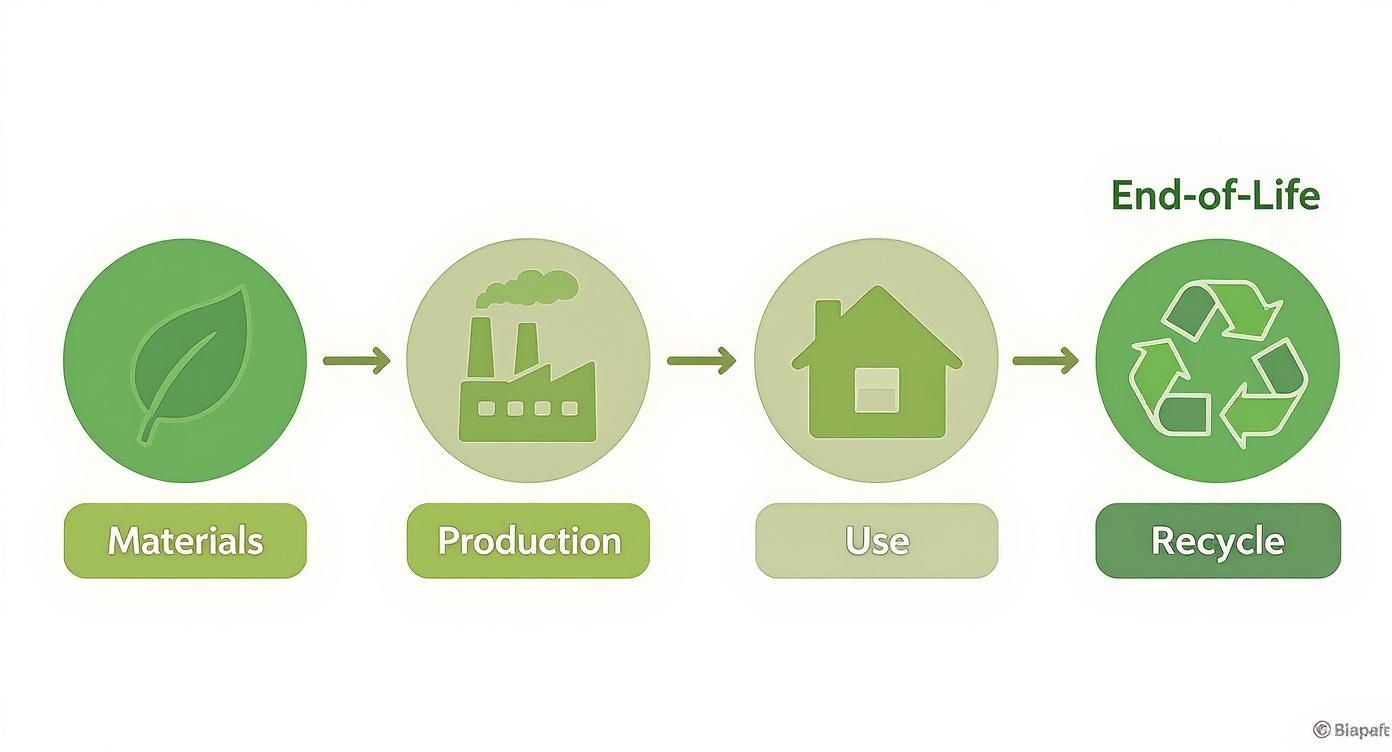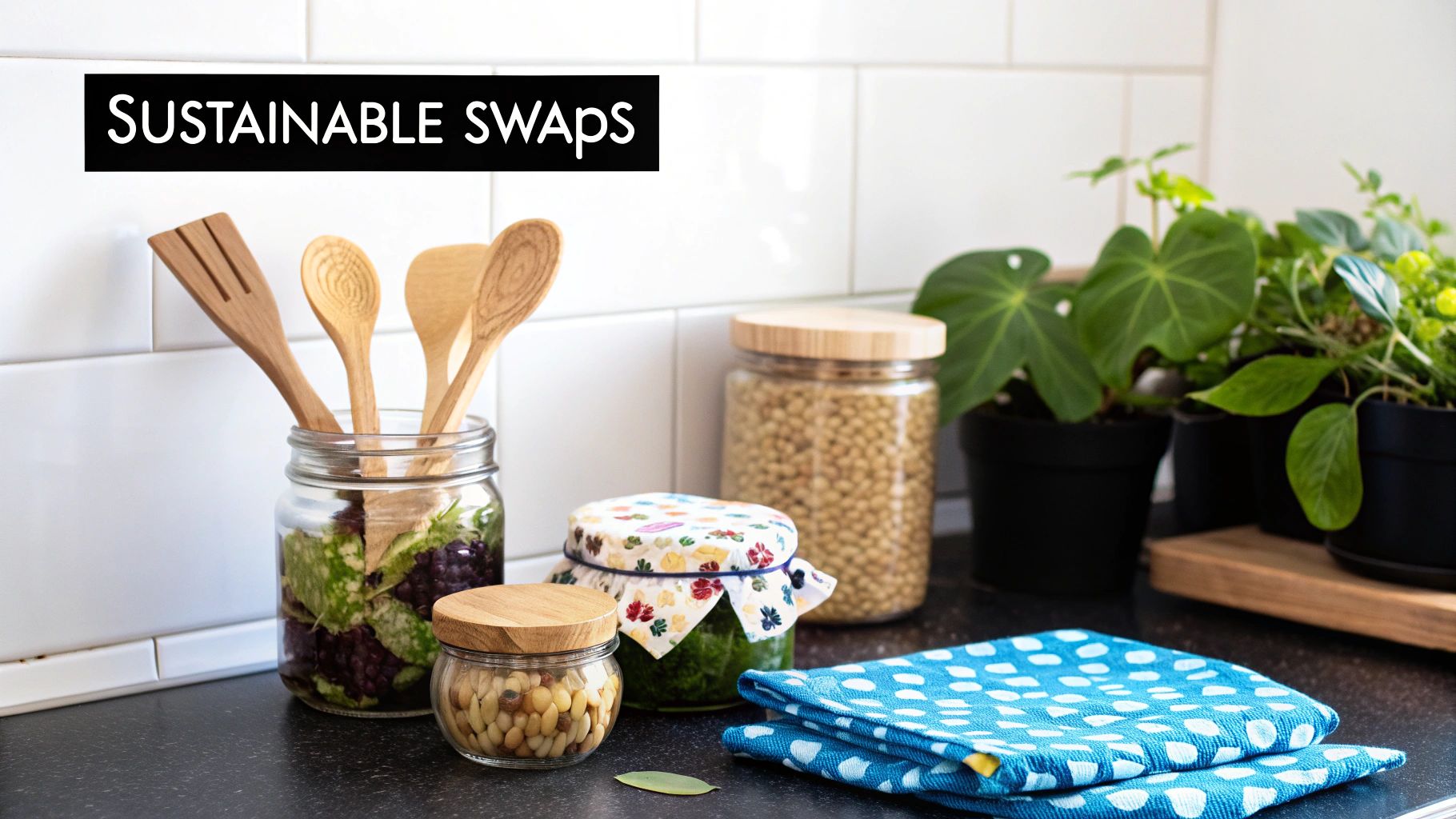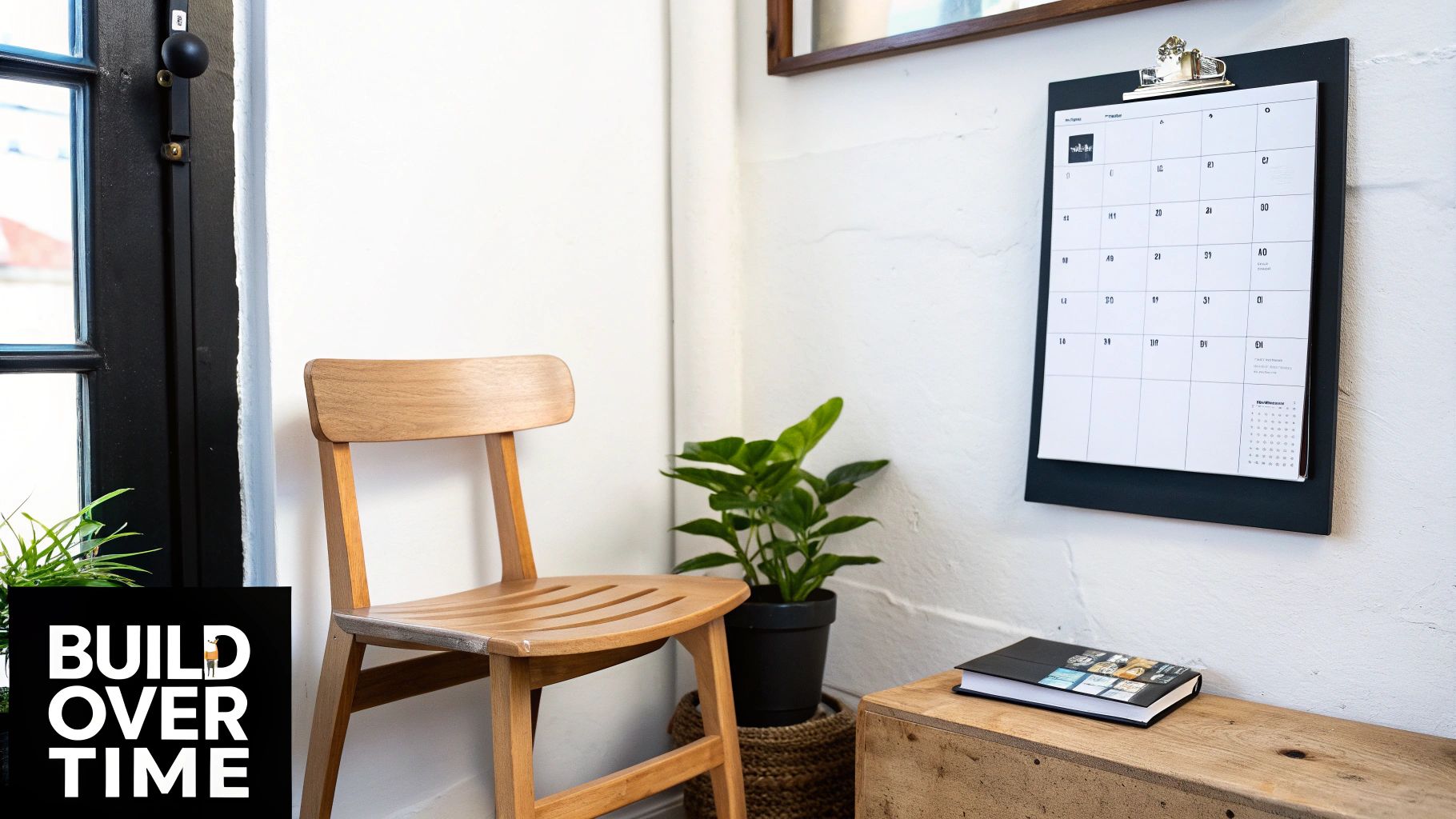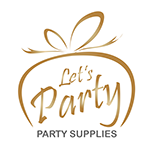
When we talk about sustainable home products, we're talking about items made from renewable or recycled materials, created through ethical manufacturing processes, and built to be durable and biodegradable or recyclable. Essentially, it’s about choosing products that are kind to the planet from start to finish.
What Actually Makes a Home Product Sustainable?
Let's cut through the greenwashing. A "sustainable home product" isn't just about a pretty green label; it's about the product’s entire lifecycle. Think of it like farm-to-table dining—the real value comes from understanding the whole journey, not just what's on your plate. A truly sustainable product has a good story to tell at every stage.
That story starts with the raw materials. Were they sourced responsibly? Bamboo, for instance, is a fast-growing grass, making it a far better choice than virgin plastic made from finite fossil fuels. In the same way, using reclaimed wood gives old materials a new life, keeping them out of landfills and reducing the need for new logging.
The Human and Environmental Footprint
But it’s not just about the materials themselves. Sustainability also has a human side. We have to consider the people who make these products, which means ensuring fair wages, safe working conditions, and respect for their communities. A product made with the "greenest" materials can't truly be called sustainable if it's the result of exploitative labor.
The core idea is simple: A product's journey should leave the world better, or at least no worse off. It considers the planet, the people involved in its creation, and its long-term impact in your home and beyond.
Durability and End of Life
Finally, a sustainable product is designed to last and have a graceful exit. The goal is to break the cycle of buying, using, and tossing. Durability is a huge part of this—an item that serves you well for 10 years creates significantly less waste than something you have to replace every year.
And when its useful life is finally over, what’s next? The best sustainable products are either:
- Recyclable: They can be broken down and turned into something new.
- Biodegradable/Compostable: They can safely return to the earth without leaving behind harmful chemicals.
To really see this in action, it helps to look at bigger-ticket items like sustainable roofing materials and eco-friendly options, which have to balance long-term durability with environmental responsibility.
How to Read Eco Labels and Materials
Stepping into the world of sustainable home products can feel like trying to decipher a secret code. You're met with a barrage of symbols, unfamiliar terms, and bold claims. It's easy to feel overwhelmed, but here's the good news: learning to recognize a few key labels and materials is the single most powerful skill you can develop to make choices that truly matter.
Think of an eco-certification as a product's background check. These labels aren't just marketing fluff; they are verified by an independent, third-party organization. This stamp of approval confirms a product meets specific, rigorous standards for its environmental or ethical impact. It's your best defense against "greenwashing"—that frustrating practice where companies use vague or misleading claims to seem more eco-friendly than they actually are.
Decoding Common Certifications
You don't need to become an expert on every single eco-label out there. The trick is to familiarize yourself with a handful of the most reputable and common ones you'll find on everything from furniture to bed sheets. These act as a reliable shortcut, instantly telling you that a product has been properly vetted.
Here are three heavy hitters to look for:
-
Forest Stewardship Council (FSC): If you see this on wood or paper products—think a dining table or paper towels—it’s a guarantee. It means the materials were sourced from responsibly managed forests that protect biodiversity and support local communities.
-
Global Organic Textile Standard (GOTS): This is the gold standard for any textiles you bring into your home, like cotton sheets, towels, or upholstery. It doesn't just mean the fibers are organic; it certifies that the entire process, from harvesting and dyeing to manufacturing, met strict environmental and social criteria.
-
Fair Trade Certified: This label shifts the focus to the people behind the product. It’s a powerful signal that the artisans and farmers involved earned fair wages and worked in safe conditions, ensuring your purchase directly supports ethical practices and helps empower communities.
Getting comfortable with these labels is a huge first step in learning how to shop sustainably and ensuring your money goes toward things you can feel good about.
This infographic gives a great overview of what a truly sustainable product's journey looks like, from its very beginning to its end.

As you can see, genuine sustainability is about the entire lifecycle, not just a single green feature.
Understanding Key Sustainable Materials
Beyond the official labels, the materials themselves tell a big part of the story. The market for low and zero-waste household products is booming for a reason. People are catching on to the power of smart material choices. Bamboo and wood currently hold the largest market share because they're renewable, while glass and stainless steel are favorites for their sheer durability and recyclability.
Here are some of the star players you’ll want to get to know:
- Bamboo: It's not wood—it's a fast-growing grass! It needs no pesticides, regenerates from its own roots, and grows incredibly quickly, making it a fantastic renewable resource for everything from cutting boards to flooring.
- Organic Cotton: Grown without the nasty cocktail of toxic pesticides and synthetic fertilizers, it's simply better for the soil, the water, and the health of the farmers who grow it.
- Reclaimed Wood: This is all about giving old materials a new life. Using wood salvaged from old barns, warehouses, or furniture not only prevents waste but also means no new trees have to be cut down. Plus, each piece comes with its own unique history and character.
- Recycled Glass and Metal: These are recycling superstars. They can be melted down and reformed over and over again without ever losing their quality, a process that uses dramatically less energy than creating them from scratch.
Practical Sustainable Swaps for Every Room

This is where all the concepts we've discussed really come to life. Building a sustainable home isn't about a massive, expensive overhaul overnight. It’s all about the small, intentional changes that add up over time.
Let's walk through your home, room by room, and pinpoint some simple swaps you can make right away. Each one—no matter how small it feels—is a step in the right direction. It means less waste in landfills, fewer resources consumed, and a clear signal to manufacturers about what you value.
Reinventing Your Kitchen
The kitchen is the heart of most homes, but it can also be a major hub for single-use waste. The good news? That makes it one of the easiest places to start making an impact.
Think about your food storage and daily cleanup routines. Ditching single-use plastics is a fantastic first step.
- Beeswax Wraps: A fantastic, reusable, and compostable alternative to plastic cling film. Perfect for covering bowls or wrapping up a sandwich.
- Silicone Storage Bags: These are game-changers. You can wash and reuse them hundreds, even thousands, of times, replacing a mountain of disposable plastic baggies.
- Solid Dish Soap Bars: Why buy a plastic bottle of mostly water? A concentrated soap bar cuts grease just as well and lasts for what feels like an eternity.
These simple adjustments make a huge dent in your plastic consumption. If you want to dive deeper into eco-friendly cleaning, our household cleaning supplies checklist can help you stock up thoughtfully.
Easy Sustainable Swaps by Room
Getting started can feel overwhelming, so here’s a quick-reference guide to some of the simplest yet most effective swaps you can make around the house.
| Room | Conventional Product | Sustainable Alternative | Primary Benefit |
|---|---|---|---|
| Kitchen | Paper Towels | Reusable Cloth Towels | Reduces single-use paper waste |
| Kitchen | Plastic Food Wrap | Beeswax Wraps or Silicone Lids | Eliminates plastic waste |
| Bedroom | Conventional Cotton Sheets | GOTS-Certified Organic Cotton | Reduces pesticide & water use |
| Bathroom | Plastic Toothbrush | Bamboo Toothbrush | Biodegradable handle |
| Bathroom | Bottled Liquid Soap | Bar Soap or Refillable Dispenser | Cuts down on plastic packaging |
| Living Room | Incandescent Light Bulbs | LED Bulbs | Drastically lowers energy use |
Remember, the goal isn't perfection; it's progress. Picking just one or two things from this list is a wonderful way to begin.
Creating a Serene and Sustainable Bedroom
Your bedroom is your sanctuary, and that feeling of peace and restfulness can be deepened by the materials you surround yourself with. The focus here is on natural, healthy, and long-lasting items. Bedding is a great place to start.
Did you know conventional cotton is one of the most pesticide-intensive crops on the planet? Switching to GOTS-certified organic cotton bedding means your sheets are free of harsh chemicals and were made using far less water.
The most sustainable product is often the one you already own. By caring for your existing textiles, furniture, and decor, you extend their lifespan and reduce the need for new consumption, which is the ultimate eco-friendly act.
When looking at furniture, keep an eye out for FSC-certified or reclaimed wood. This certification guarantees your bed frame or dresser came from responsibly managed forests or gives beautiful old materials a second life.
Upgrading the Bathroom and Living Areas
The bathroom is another hotspot for single-use plastics. Swapping a plastic soap bottle for a simple bar is a classic for a reason, but why stop there? Think about bamboo toothbrushes, refillable hand soap, and toilet paper made from recycled materials.
In your main living spaces, consider the long-term journey of your furniture and decor. The sustainable home decor market is booming, which is great news for all of us. Recent data shows furniture commands 45% of the market, with textiles at 30% and lighting at 25%. This consumer-driven trend is pushing big retailers to offer more ethical and circular options.
Instead of chasing fleeting trends, prioritize quality craftsmanship and timeless design. A well-made sofa upholstered in natural fibers will outlast several cheaper versions, saving you money and saving resources from the landfill. And one of the easiest wins? Switching to LED bulbs. It’s a tiny change that significantly cuts your energy use and your electricity bill. Every choice adds up.
The True Impact of Your Choices
It’s easy to think of choosing sustainable products as just buying a new set of towels or a bamboo cutting board. But that simple decision sends a powerful ripple effect far beyond your front door. It’s a direct vote for a healthier planet and a more equitable world, connecting your individual choices to a much larger, global picture.
Most of our modern economy works on a straight line: we take resources, make stuff, use it for a bit, and then throw it away. This "take-make-waste" model is incredibly wasteful and chews through finite resources. When you choose sustainable items, you're backing a circular economy instead—a smarter system where things are designed to be reused, repaired, or safely returned to nature, cutting out waste from the very beginning.
From Your Cart to the Global Community
Your wallet is one of the most powerful tools you have for driving change. When you pick items made from recycled materials, you're helping to shrink the mountains of waste headed for our landfills. When you choose furniture made from FSC-certified wood, you're directly supporting the conservation of vital forests and the incredible biodiversity they hold.
And it’s not just about the planet; your choices have a profound human impact, too. You’re supporting companies that are committed to fair labor, ensuring the people who make your products are treated with dignity and paid a living wage. This creates demand for green manufacturing and nudges the entire market toward better, more responsible practices. Simple household shifts, like learning how to reduce energy consumption in your home, are part of this bigger picture.
Every sustainable product you bring into your home is a tangible investment in the future. It's a small act that, when multiplied by millions of conscious consumers, reshapes industries and protects our shared environment.
This consumer-driven movement is already making serious economic waves. The sustainable products market was valued at $389.28 billion in 2024 and is on track to hit $432.67 billion in 2025, with North America leading the way.
This incredible growth is happening because people like you are demanding more transparency and ethical production from the brands they buy from. You can read more about the growth of the sustainable products market and see how our collective actions are truly adding up. This isn't just a fleeting trend; it’s a fundamental shift toward a more mindful and responsible way of living.
Building a Sustainable Home Over Time

Let's be realistic: transforming your home into a sustainable haven doesn't happen overnight. There’s a persistent myth that "going green" demands a massive, expensive, all-or-nothing overhaul. The reality is much kinder and far less stressful. The journey is all about progress, not instant perfection.
This long-term mindset allows you to make thoughtful, high-impact changes without feeling overwhelmed or breaking the bank. Forget the complete redesign. Instead, think of it as a gradual evolution that fits your life and your budget. The real goal is to build conscious habits and make better choices, one at a time.
The Replace-as-Needed Method
One of the most practical and wallet-friendly strategies is the replace-as-needed method. It’s exactly what it sounds like. When a household item finally gives up the ghost, you consciously choose a sustainable product to take its place. Did your plastic food containers finally crack? Perfect. Now’s your chance to switch to durable glass or stainless steel alternatives.
This approach is brilliant for a few reasons:
- It’s easy on your budget. You avoid the huge upfront cost of replacing everything at once, spreading the investment out naturally over time.
- It cuts down on waste. You’re getting the absolute maximum life out of your existing items, which is the most sustainable thing you can do.
- It keeps things manageable. Instead of a daunting to-do list, you have one simple, focused task each time something needs replacing.
This method cleverly turns the chore of buying replacements into an opportunity to upgrade your home with better, more thoughtful sustainable home products.
Prioritizing Care and Maintenance
Before you even think about buying something new, remember that the most sustainable practice is simply taking care of what you already own. Extending the life of your current belongings—from your sofa and clothes to your kitchen appliances—is a powerful way to fight consumption and waste.
The ultimate act of sustainability isn't just about what you buy; it's about how you care for what you have. A well-maintained item, regardless of its material, keeps resources out of the landfill and reduces the demand for new production.
Simple routines, like cleaning your appliance filters regularly or fixing that wobbly chair leg, can add years to an item's life. This mindset even applies to technology; you can explore the best smart home devices that are not only designed for energy efficiency but also built to last.
By embracing this philosophy of care and mindful replacement, the transition to a sustainable home feels not just achievable, but genuinely rewarding. It’s a journey built on a series of small, intentional decisions that add up to a significant, positive impact—for your home and for the planet.
Answering Your Sustainability Questions
https://www.youtube.com/embed/E9llTvX0yzw
Stepping into the world of sustainable living always sparks a few questions. It’s a space filled with new terms and fresh ideas, so it's completely natural to want some clarity before you dive in. Getting these answers upfront can make the whole process feel less intimidating and a lot more rewarding right from the start.
Let's tackle the big one first: price. Are sustainable products always more expensive? The initial price tag can sometimes be higher, but that’s rarely the whole story. What you’re really paying for is better quality, materials sourced with care, and fair wages for the people who made the product.
Think of it this way: many sustainable items deliver incredible long-term value. A well-made piece that lasts for a decade is far more budget-friendly than something you have to replace every single year.
It’s a simple shift from thinking about upfront cost to considering lifetime value. For instance, a reusable silicone food bag costs more than one box of disposable plastic baggies, but it eliminates the need to buy hundreds of them over its lifetime. You end up saving money and keeping a mountain of plastic out of the landfill.
How Can I Spot Greenwashing?
"Greenwashing" is a sneaky marketing tactic companies use to make you think their products are more environmentally friendly than they actually are. They’re banking on your good intentions. The good news is, once you know what to look for, the red flags are pretty easy to spot.
Keep an eye out for vague or meaningless claims. Here are a few common ones:
- "Eco-Friendly" or "All-Natural": These sound nice, but without any specifics to back them up, they're just marketing fluff. A genuinely sustainable brand will tell you why their product is a better choice.
- Irrelevant Claims: You might see a product proudly labeled "CFC-free." The catch? CFCs have been banned for decades, so this isn't a special feature—it's just a distraction.
- Hidden Trade-Offs: A company might highlight that a product is made from recycled materials while conveniently forgetting to mention it was produced in a factory with terrible labor practices.
The best way to cut through the noise is to look for those third-party certifications we mentioned earlier. When you see a logo like FSC or GOTS, you can trust that the product has met strict, independent standards. It’s proof, not just a promise.
So, where should you start? What’s the single most impactful swap you can make? While the answer is different for everyone, you can’t go wrong by starting in the kitchen. Swapping out single-use items like paper towels for reusable cloths or plastic wrap for beeswax wraps are small, simple changes. But they make a tangible difference you can see every day, building the momentum you need to keep going.
At FindTopTrends, we curate high-quality essentials that align with a modern, mindful lifestyle. Explore our collection to discover products that bring lasting value and style to your home. Find your next favorite essential at https://findtoptrends.com.










